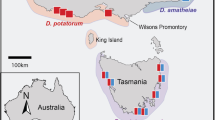Abstract
The most recent in the continuing series of international conferences dedicated to charrs, Salvelinus species, was held in Reykjavik, Iceland 1–5 August 2006.
Similar content being viewed by others
Avoid common mistakes on your manuscript.
The most recent in the continuing series of international conferences dedicated to charrs, Salvelinus species, was held in Reykjavik, Iceland 1–5 August 2006. The Symposium was organized and hosted by two committees. The Scientific Committee included: Sigurður S. Snorrason, University of Iceland, Skúli Skúlason, Hólar University College, Bjarni Jónsson, Institute of Freshwater Fisheries, Bjarni K. Kristjánsson, Hólar University College, Hilmar J. Malmquist, The Natural History Museum of Kopavogur, Ingi Rúnar Jónsson, Institute of Freshwater Fisheries, Þórólfur Antonsson, Institute of Freshwater Fisheries, Colin Adams, University of Glasgow, and David L.G. Noakes, Oregon State University. The Organizing Committee consisted of: Sigurður S. Snorrason, University of Iceland, Bjarni Jónsson, Institute of Freshwater Fisheries, Bjarni K. Kristjánsson, Hólar University College, Hilmar J. Malmquist, the Natural History Museum of Kópavogur, Ingi Rúnar Jónsson, Institute of Freshwater Fisheries, Skúli Skúlason, Hólar University College, and Þórólfur Antonsson, Institute of Freshwater Fisheries. Major sponsors of the Symposium were the University of Iceland, Holar University College, the Natural History Museum of Kópavogur, and Ministries of the Government of Iceland. All sessions were held in Askja, the Natural Sciences Building of the University of Iceland.
The papers in this special issue from the Symposium reflect more than 60 papers presented by delegates from more than 15 countries in both oral papers and poster paper sessions during the Symposium. An important contribution is the tribute to Lionel Johnson, the foremost Canadian charr researcher, a true pioneer in the study of charr biology and the organizer and host of the first International Charr Symposium. His continuing influence is shown not only by this contribution but also by the research of his collaborators and ideas in many of the other papers in this issue. Of course the diversification of charrs, in life history, reproductive behavior and foraging behavior is a continuing theme in several of the papers. The responses of charr populations to exploitation, climate change and invasive species are other important emerging themes. Details of the adaptations of charrs to a range of local conditions, including some remarkable deepwater lakes, point the way to future studies of these remarkable fishes. In all the papers in this issue, there is continuity with studies presented at earlier Charr Symposia, in terms of the geography, the major research laboratories devoted to these species, and the growing body of information that contributes to our understanding of charrs. Perhaps the major collective contribution of the Reykjavik Symposium will be the recognition of the importance of process, in addition to the long-standing focus on pattern. I emphasized that theme in my own keynote presentation, and I have summarized my thoughts as an Editorial in this issue.
The next International Charr Symposium is scheduled for Glasgow, Scotland in 2009. We look forward to that Symposium with enthusiasm for our science, eagerness to meet old friends and new colleagues and dedication to continue our joint efforts to understand our charrs (Figs. 1, 2, 3, 4, 5, 6, 7, 8, 9, 10).
Author information
Authors and Affiliations
Corresponding author
Rights and permissions
About this article
Cite this article
Noakes, D.L.G. 2006 International Charr Symposium, Reykjavik, Iceland. Environ Biol Fish 83, 1–5 (2008). https://doi.org/10.1007/s10641-008-9378-y
Received:
Accepted:
Published:
Issue Date:
DOI: https://doi.org/10.1007/s10641-008-9378-y














